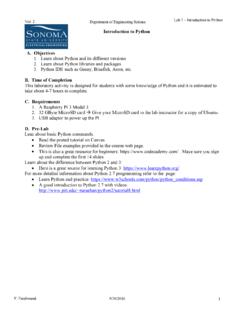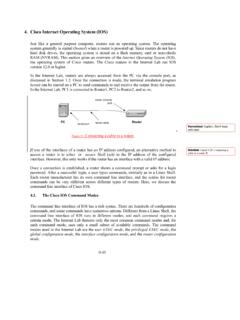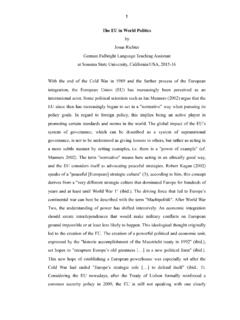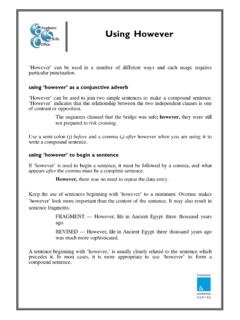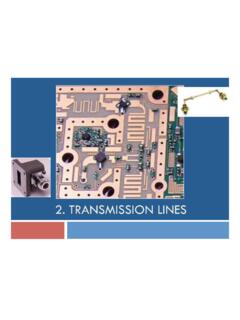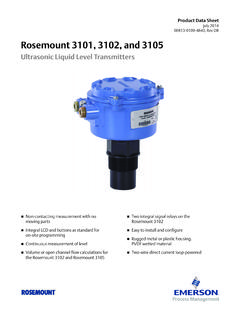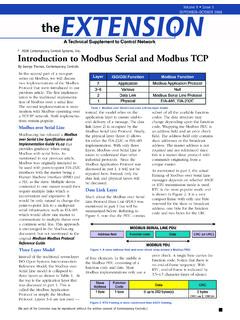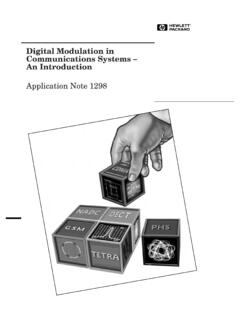Transcription of Introduction to Communication Systems and Networks
1 Introduction to Communication Systems and Networks Dr. Farid Farahmand Updated 8/31/2010 Telecommunications n Tele (Far) + Communications n Early telecommunications n smoke signals and drums n visual telegraphy (or semaphore in 1792) n Telegraph and telephone n Telegraph (1839) n Telephone (1876) n Radio and television n Telephony n Voice and Data Communications and Networks n Data Communications n Transmission of signals n Encoding, interfacing, signal integrity, multiplexing etc. n Networking n Topology & architecture used to interconnect devices n Networks of Communication Systems Network Trends (1980-Present) Processors Networking Data Communications Applications: Voice, Image, Data, Video Integrated Systems ! Communication Systems n Process describing transfer of information, data, instructions between one or more Systems through some media n Examples n people, computers, cell phones, etc.
2 N Computer Communication Systems n Signals passing through the Communication channel can be Digital, or analog n Analog signals: continuous electrical waves n Digital signals: individual electrical pulses (bits) n Receivers and transmitters: desktop computers, mainframe computers, etc. TX RX RX RX Communication channel Communication media Amp/Adaptor Communication Systems Communications Components n Basic components of a Communication system n Communication technologies n Communication devices n Communication channels n Communication software A Communications Model Communications Tasks Transmission system utilization Addressing Interfacing Routing Signal generation Recovery Synchronization Message formatting Exchange management Security Error detection and correction Network management Flow control Data Communications Model Communication Technology Applications voice mail Twitter e-mail instant messaging chat rooms newsgroups telephony videoconferencing collaboration groupware global positioning system (GPS)
3 Communication Technologies - Applications n Different technologies allowing us to communicate n Examples: Voice mail, fax, email, instant message, chat rooms, news groups, telephony, GPS, and more n Voice mail: Similar to answering machine but digitized n Fax: Sending hardcopy of text or photographs between computers using fax modem n Email: electronic mail sending text, files, images between different computer Networks - must have email software n More than billion people send 244 billion messages monthly! n Chat rooms: Allows communications in real time when connected to the Internet n Telephony: Talking to other people over the Internet (also called VoIP) n Sends digitized audio signals over the Internet n Requires Internet telephone software n Groupware: Software application allowing a group of people to communicate with each other (exchange data) n Address book, appointment book, schedules, etc.
4 N GPS: consists of receivers connected to satellite Systems n Determining the geographical location of the receiver n Used for cars, advertising, hiking, tracking, etc. Communication Devices n Any type of hardware capable of transmitting data, instructions, and information between devices n Functioning as receiver, transmitter, adaptor, converter n Basic characteristics: How fast, how far, how much data! n Examples: Dial-up modems, ISDN, DSL modems, network interface cards n Dial-up modem: uses standard phone lines n Converts digital information into analog n Consists of a modulator and a demodulator n Can be external, internal, wireless n ISDN and DSL Modem: Allows digital Communication between Networks and computers n Requires a digital modem n Digital is better than analog why?
5 N Cable modem: a modem that transmits and receives data over the cable television (CATV) network n Also called broadband modem (carrying multiple signals) n The incoming signal is split n Requires a cable modem n Network interface cards: Adaptor cards residing in the computer to transmit and receiver data over the network (NIC) n Operate with different network technologies ( , Ethernet) Communication Software n Examples of applications (Layer 7) take advantage of the transport (Layer 4) services of TCP and UDP n Hypertext Transfer Protocol (HTTP): A client/server application that uses TCP for transport to retrieve HTML pages. n Domain Name Service (DNS): A name-to-address translation application that uses both TCP and UDP transport.
6 N Telnet: A virtual terminal application that uses TCP for transport. n File Transport Protocol (FTP): A file transfer application that uses TCP for transport. n Trivial File Transfer Protocol (TFTP): A file transfer application that uses UDP for transport. n Network Time Protocol (NTP): An application that synchronizes time with a time source and uses UDP for transport. n Border Gateway Protocol (BGP): An exterior gateway routing protocol that uses TCP for transport. BGP is used to exchange routing information for the Internet and is the protocol used between service providers. Communication Channels n A channel is a path between two Communication devices n Channel capacity: How much data can be passed through the channel (bit/sec) n Also called channel bandwidth n The smaller the pipe the slower data transfer!
7 N Consists of one or more transmission media n Materials carrying the signal n Two types: n Physical: wire cable n Wireless: Air destination network server T1 lines T1 lines T1 lines T3 lines Physical Transmission Media n A tangible media n Examples: Twisted-pair cable, coaxial cable, Fiber-optics, etc. n Twisted-pair cable: n One or more twisted wires bundled together (why?) n Made of copper n Coax-Cable: n Consists of single copper wire surrounded by three layers of insulating and metal materials n Typically used for cable TV n Fiber-optics: n Strands of glass or plastic used to transmit light n Very high capacity, low noise, small size, less suitable to natural disturbances Physical Transmission Media plastic outer coating woven or braided metal insulating material copper wire twisted-pair cable twisted-pair wire protective coating glass cladding optical fiber core Wireless Transmission Media n Broadcast Radio n Distribute signals through the air over long distance n Uses an antenna n Typically for stationary locations n Can be short range n Cellular Radio n A form of broadcast radio used for mobile Communication n High frequency radio waves to transmit voice or data n Utilizes frequency-reuse Wireless Transmission Media n Microwaves n Radio waves providing high speed transmission n They are point-to-point (can t be obstructed)
8 N Used for satellite Communication n Infrared (IR) n Wireless transmission media that sends signals using infrared light- waves - Such as? Physical Transmission Media 100 Mbps is how many bits per sec? Which is bigger: 10,000 Mbps, or 10 Gbps? Wireless channel capacity: Networks n Collection of computers and devices connected together n Used to transfer information or files, share resources, etc. n What is the largest network? n Characterized based on their geographical coverage, speed, capacities n Networks are categorized based on the following characteristics: n Network coverage: LAN, MAN, WAN n Network topologies: how the computers are connected together n Network technologies n Network architecture Network coverage n Local Area Networks : n Used for small Networks (school, home, office) n Examples and configurations: n Wireless LAN or Switched LAN n ATM LAN, Frame Ethernet LAN n Peer-2-PEER: connecting several computers together (<10) n Client/Server.
9 The serves shares its resources between different clients n Metropolitan Area Network n Backbone network connecting all LANs n Can cover a city or the entire country n Wide Area Network n Typically between cities and countries n Technology: n Circuit Switch, Packet Switch, Frame Relay, ATM n Examples: n Internet P2P: Networks with the same network software can be connected together (Napster) LAN WAN LAN - Local Area Network a group of computers connected within a building or a campus (Example of LAN may consist of computers located on a single floor or a building or it might link all the computers in a small company. WAN - A network consisting of computers of LAN's connected across a distance WAN can cover small to large distances, using different topologies such as telephone lines, fiber optic cabling, satellite transmissions and microwave transmissions.)
10 Network Topologies n Configuration or physical arrangement in which devices are connected together n BUS Networks : Single central cable connected a number of devices n Easy and cheap n Popular for LANs n RING Networks : a number of computers are connected on a closed loop n Covers large distances n Primarily used for LANs and WANs n STAR Networks : connecting all devices to a central unit n All computers are connected to a central device called hub n All data must pass through the hub n What is the problem with this? n Susceptible to failure Network Topologies personal computer personal computer personal computer personal computer personal computer host computer printer file server personal computer personal computer personal computer personal computer Network Architecture n Refers to how the computer or devices are designed in a network n Basic types: n Centralized using mainframes n Peer-2-Peer: n Each computer (peer) has equal responsibilities, capacities, sharing hardware, data, with the other computers on the peer-to-peer network n Good for small businesses and home Networks n Simple and inexpensive n Client/Server.

